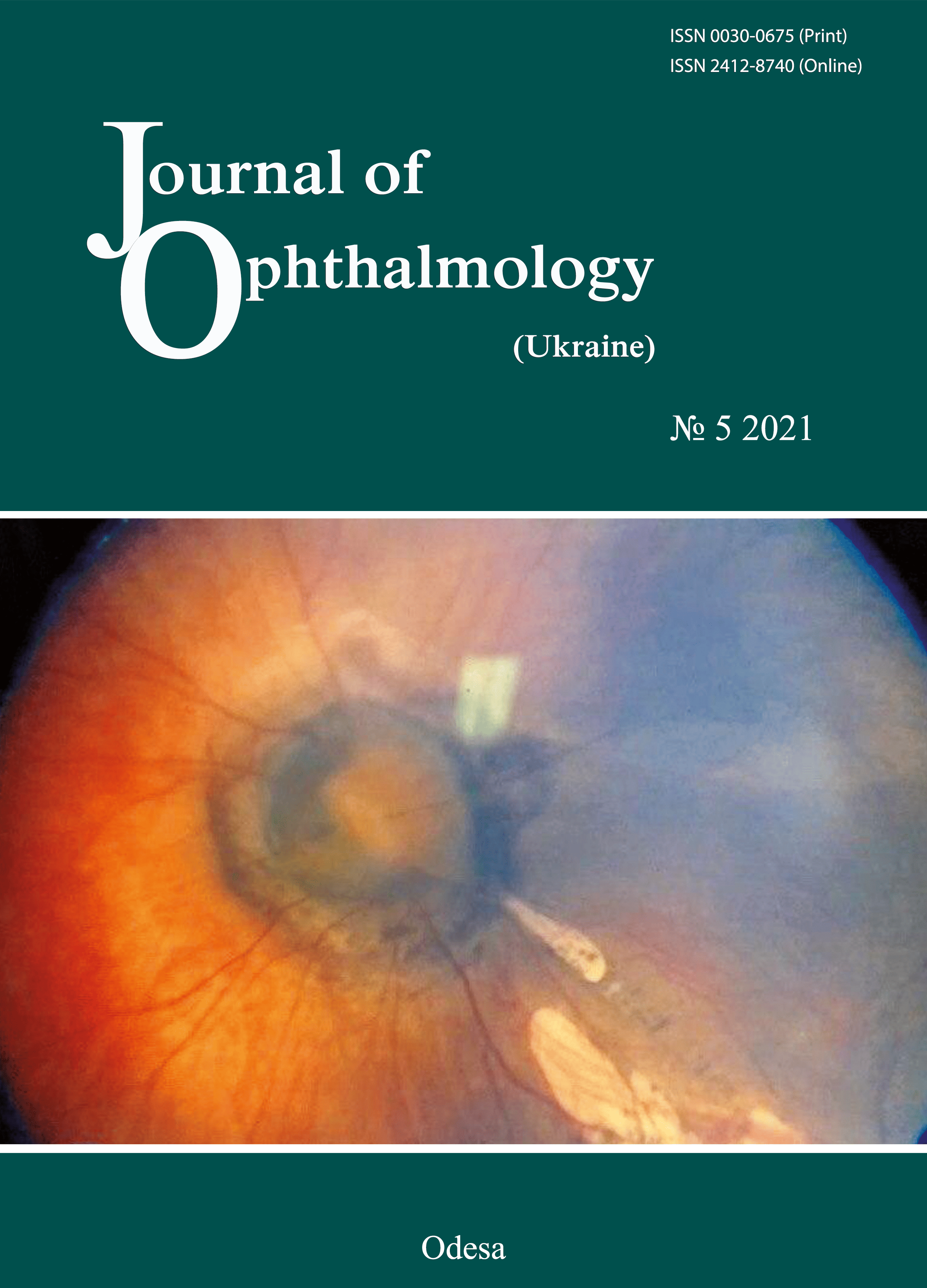Avoiding errors in the diagnosis of polypoidal choroidal vasculopathy in patients with age-related macular degeneration (Part 2: Example cases)
DOI:
https://doi.org/10.31288/oftalmolzh202157783Keywords:
optical coherence tomography, optical coherence tomography angiography, age-related macular degeneration, polypoidal choroidal vasculopathy, differential diagnosisAbstract
Polypoidal choroidal vasculopathy (PCV) is difficult to diagnose subtype of neovascular age-related macular degeneration (nAMD). Although advances in optical coherence tomography (OCT) and OCT angiography (OCTA) have allowed much improved diagnosis of PCV when indocyanine green angiography (ICGA), a gold-standard for diagnosing PCV, is unavailable, the task may still represent a challenge even for the most experienced ophthalmologists. Numerous diagnostic errors (including failure in elicitation or interpretation of symptoms or signs) may be partially due to the absence of a universal algorithm for identification of the pathology. We believe that highlighting the pathological features of importance to confirm diagnosis, and developing a clearly defined sequence of steps for interpretation of OCT and OCTS results will be a valuable approach to improved diagnosis of this type of nAMD. Three nAMD cases that had OCT signs consistent with PCV and required further differential diagnostic assessment to confirm or exclude PCV are presented as examples demonstrating the efficacy of the proposed algorithm. In these example cases, the OCT findings suggestive of PCV are reported, and OCTA segmentation steps with the related actions as per the proposed algorithm are described. The example cases demonstrate that the stepwise assessment of OCT and OCTA results for patients with nAMD allows to determine reliably whether PCV is present or not (i.e., whether the diagnosis should be confirmed or refuted).
References
1. Lutsenko NS, Rudycheva OA, Isakova OA, Kyrylova TS. Assessing OCTA changes in morphology and structure of retinal microvascular bed in patients with exudative AMD. J Ophthalmol (Ukraine). 2019;2:7-13. https://doi.org/10.31288/oftalmolzh20192713
2. Lutsenko NS, Isakova OA, Rudycheva OA, Kyrylova TS, Unguryan NV. [Macula. Today's diagnostics. (Optical coherent tomography and Optical coherent tomography angiography)]. Zaporizhzhia: Orbita-Yug Agency; 2019. Ukrainian.
3. Shaimov TB, Panova IP, Shaimov RB, Shaimov TA, Fomin AV. [Optical coherence tomography-angiography in the diagnosis of neovascular age-related macular degeneration]. Bull of Ophthalmology. 2015 Sep-Oct;131(5):4-13. Russian.https://doi.org/10.17116/oftalma201513154-12
4. Lumbroso B, Huang D, Souied EH, Savastano MC, Jia Y, Rispoli M. Understanding OCT Angiography from Pathophysiology to Clinical Imaging. 1st ed. New Delhi: Jaypee Brothers medical Publishers; 2019.
5. Borrelli E, Battista M, Gelormini F. Sacconi R, Querques L, Vella G, Vigano C, Bandello F, Querques G. Rate of misdiagnosis and clinical usefulness of the correct diagnosis in exudative neovascular maculopathy secondary to AMD versus pachychoroid disease. Sci Rep. 2020;10:20344.https://doi.org/10.1038/s41598-020-77566-1
6. Lauermann JL, Woetzel AK, Treder M, Alnawaiseh M, Clemens CR, Eter N, Alten F. Prevalences of segmentation errors and motion artifacts in OCT-angiography differ among retinal diseases. Graefes Arch Clin Exp Ophthalmol. 2018 Oct;256(10):1807-16.https://doi.org/10.1007/s00417-018-4053-2
7. Cheung CMG, Lai TYY, Ruamviboonsuk P, Chen S, Chen Y, Freund KB, Gomi F, Koh AH, Lee WK, Wong TY. Polypoidal Choroidal Vasculopathy. Definition, Pathogenesis, Diagnosis, and Management. Ophthalmology. 2018 May;125(5):708-724.https://doi.org/10.1016/j.ophtha.2017.11.019
8. Shaymov TB, Panova YE, Shaymova VA. [Differential diagnostic criteria in the diagnosis of polypoid choroidal vasculopathy as a variant of the course of the neovascular stage of age-related macular degeneration. Modern technologies in ophthalmology]. Russ ophthalmol onl [Internet]. 2017 Mar 1;1(14):335-9. Russian.
9. Tomiyasu T, Nozaki M, Yoshida M, Ogura Y. Characteristics of polypoidal choroidal vasculopathy evaluated by optical coherence tomography angiography. Invest Ophthalmol Vis Sci. 2016 July;57(9):324-30.https://doi.org/10.1167/iovs.15-18898
10. Shaymov TB, Panova YE, Shaymova VA. [Algorithm for non-invasive clinical and instrumental diagnostics of polypoid choroidal vasculopathy. Modern technologies in ophthalmology]. Russ ophthalmol onl [Internet]. 2018 Jun 14;1(21):402-407. Russian.
11. Yang J, Yuan M, Wang E, Xia S, Chen Y. Noninvasive multimodal imaging in diagnosing polypoidal choroidal vasculopathy. BMC Ophthalmol. 2019 Nov 16;19(1):229-36.https://doi.org/10.1186/s12886-019-1244-5
12. National Institute for Health and Care Excellence. Age-related macular degeneration: diagnosis and management [Internet]. London: NICE; 2018 Jan;Clinical guideline (NG82):244. Available from: https://www.nice.org.uk/guidance/ng82/evidence/full-guideline-pdf-170036.
13. Lutsenko NS, Rudycheva OA, Isakova OA, Kyrylova TS. How to avoid mistakes in the diagnosis of polypoid choroidal vasculopathy in patients with age-related macular degeneration (part one). J Ophthalmol (Ukraine). 2021;4: 32-38.
Downloads
Published
How to Cite
Issue
Section
License
Copyright (c) 2025 Н. С. Луценко, О. А. Рудычева, О. А. Исакова, Т. С. Кириллова

This work is licensed under a Creative Commons Attribution 4.0 International License.
This work is licensed under a Creative Commons Attribution 4.0 International (CC BY 4.0) that allows users to read, download, copy, distribute, print, search, or link to the full texts of the articles, or use them for any other lawful purpose, without asking prior permission from the publisher or the author as long as they cite the source.
COPYRIGHT NOTICE
Authors who publish in this journal agree to the following terms:
- Authors hold copyright immediately after publication of their works and retain publishing rights without any restrictions.
- The copyright commencement date complies the publication date of the issue, where the article is included in.
DEPOSIT POLICY
- Authors are permitted and encouraged to post their work online (e.g., in institutional repositories or on their website) during the editorial process, as it can lead to productive exchanges, as well as earlier and greater citation of published work.
- Authors are able to enter into separate, additional contractual arrangements for the non-exclusive distribution of the journal's published version of the work with an acknowledgement of its initial publication in this journal.
- Post-print (post-refereeing manuscript version) and publisher's PDF-version self-archiving is allowed.
- Archiving the pre-print (pre-refereeing manuscript version) not allowed.












